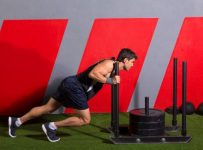
Add some variety to your diet with these less obvious sources of the muscle-building nutrient.
You may think you know all their is to know about protein—but you might be surprised…
“Oftentimes, protein is only associated with building muscles, but it has so much more to offer,” says Jordan Mazur, MS, RD, director of sports nutrition at the University of California, Berkeley. “Protein consumption in our diets is not only critical to building and supporting our lean body mass, or muscle; it’s also important for a number of functions and structures in the human body,” he explains. It helps make enzymes and hormones, boosts energy levels, helps your memory stay sharp, helps control mood swings, stabilizes blood sugar levels, and can help you maintain or lose weight by promoting fullness and satiety. “Protein is also the second most abundant substance in the body after water,” Mazur says. It’s a crucial power source for your body’s cells.
Obviously you associate protein with heavy hitters like steak, chicken, fish, eggs, and dairy. But, Mazur says, there are alternative sources of protein that can add a new range of nutrients and eliminate some of the monotony in your diet. Here are 10.
Adzuki Beans
These small, red (they can also be white, black, or gray) beans are native to China. Sometimes mashed into a paste, the legume is versatile and can be thrown in soups and chili, tossed in a salad, added to stew, served over rice or quinoa; they can sub in for pretty much any other bean.
17g protein per cup of cooked beans
Tempeh
Tempeh isn’t a food in most guys’ diets, but it should be. It’s one of the most nutrient-dense soy products; it also happens to be fermented, so it serves as a probiotic. Just 4 ounces provides 41 percent of your daily value for protein. It has a firmer texture than tofu and tastes slightly sweet and earthy.
15g protein in 1⁄2 cup
Oysters
If you toss back half a dozen oysters, you’re looking at 30g of protein. Seriously, these little guys pack a huge protein punch. They’re also high in iron and can be served up any number of ways: fresh, grilled, steamed, or roasted.
5g protein per medium oyster
Lentils
If you want to eat your way to a leaner body, fill up your tank with high-fiber, high-protein lentils. They don’t have many carbs yet are high in folate, iron, and magnesium, which help circulation through the body.
20g protein per cup boiled
Hemp Seeds
These powerful seeds are loaded with omega-3 and omega-6 essential fatty acids, iron, and magnesium. Research has also found hemp seeds can fight heart disease and lower blood pressure and cholesterol. Add them to smoothies for a kick of protein. Check out these other crazy-healthy smoothie ingredients you probably aren’t using.
10g protein per 3 tablespoons
Canned Salmon
Salmon is generally more sustainable and less toxic than tuna; not to mention the canned stuff is also a better bargain and far easier to prepare. Throw together canned salmon, quinoa, and spinach for a power salad. You’ll get a healthy dose of heart-boosting omega-3 fatty acids and protein. Just opt for these BPA-free can brands.
40g protein per 6 oz can
Brazil Nuts
Aside from packing an impressive amount of protein, Brazil nuts are best known for their selenium content. Just 1 ounce has way more than the recommended daily intake of the antioxidant, which can fight free radicals—the particles that damage cells and cause diseases like cancer and heart disease. You can also buy powdered Brazil nuts and sprinkle them in oatmeal, yogurt, and shakes.
14g protein per 1⁄2 cup
Pepitas (Pumpkin Seed)
Pepita is just the Spanish term for pumpkin seeds. The protein-rich seeds can give you a natural burst of energy to power through workouts and bolster salads, oatmeal, smoothies, and more. Pumpkin seeds are a good source of healthy fats and fiber, too.
7g protein per oz, or a small handful
Soy Beans
Soy bean consumption is a hotly debated topic, with some research saying it can cause “man boobs” and act like estrogen; but clinical studies don’t support that supposed effect of soy on a man’s testosterone levels. Soybeans are a complete protein, so they contain all the essential amino acids the body needs from food since it can’t be produced internally.
20-30g protein per cup
Quinoa
Quinoa has been touted as the ultimate grain, and for good reason. It’s got all nine essential amino acids, which are key for muscle building. Pair it with salmon, chicken, and any other food on this list to up your intake at every meal.
10g protein per cup
Source: http://www.mensfitness.com/nutrition/what-to-eat/10-high-protein-foods-youre-not-eating-should







